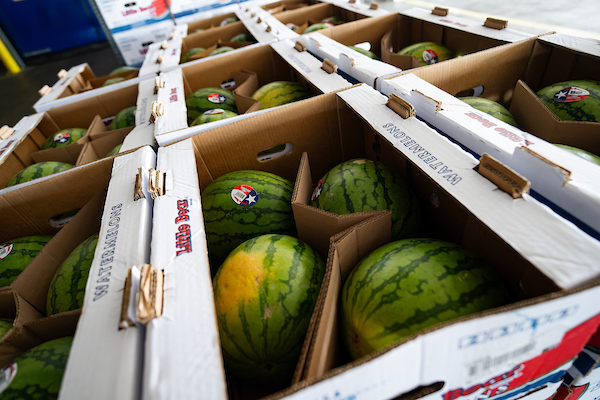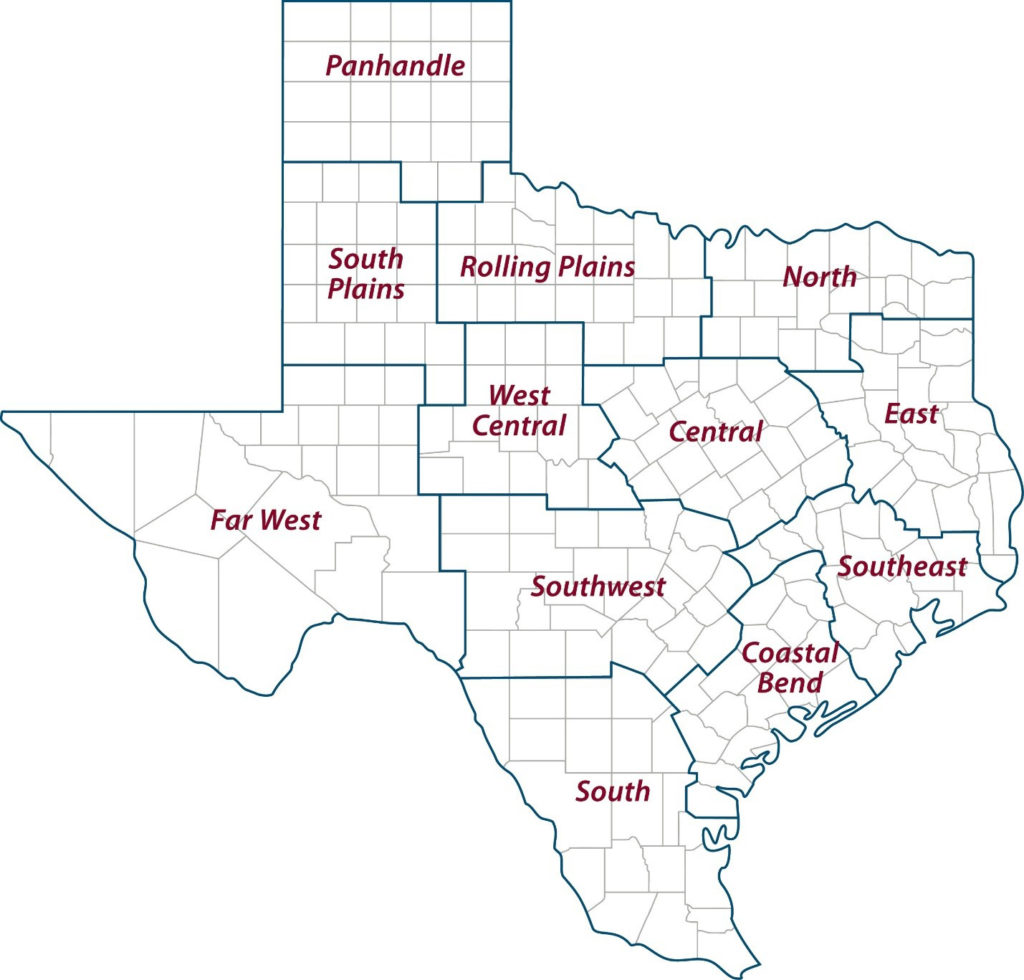Heat makes for sweet watermelons, very good yields
Texas Crop and Weather Report
Texas watermelon growers are reporting very good yields and high quality this year, according to Texas A&M AgriLife Extension Service experts.

Producers in both of the state’s primary growing regions, the Rio Grande Valley and Winter Garden, report a strong season with minimal issues producing the summertime-favorite melon.
“Overall, we are seeing more pounds per acre this year,” said Juan Anciso, Ph.D., AgriLife Extension horticulture program leader and associate head of the Texas A&M Department of Horticultural Science based at the Texas A&M AgriLife Research and Extension Center at Weslaco. “Quality is also very high this year with good sweetness levels.”
Weather, prices good for watermelon growers
Anciso said the season started with producers getting much higher prices per pound than last year, in the low 30-cent-per-pound range. But prices have since declined, and producers are getting between 18-22 cents per pound. That is slightly down from this same time last year, but Anciso said prices overall have been on par with last season.
A few producers had pest or disease issues or suffered losses from hail, but for the industry as a whole, it was a very good growing season, said Larry Stein, Ph.D., AgriLife Extension horticulturist and professor in the Department of Horticultural Sciences, Uvalde.
The heat has helped producers realize more weight per melon than in past years, Stein said. The hotter weather also helped the melons develop good brix counts, which weren’t as good last year because of untimely rains. Brix is the measurement of sugar in fruit.
“Watermelons love the heat,” Stein said. “We have had what they call ‘watermelon weather,’ and as long as producers have the water they need, that makes for good production and excellent melons.”
Harvesting of watermelons
The Rio Grande Valley has been dry for most of the growing season, which led to a later and longer harvest than usual, with watermelons still being picked last week. The drier weather and limited irrigation water in the Valley shifted some production to the Winter Garden.
“Our production is actually up in the Winter Garden this year because of the lack of water in the Valley,” Stein said. “We have had some production coming up to us because of the water shortage there, and our plants are doing well.”
Harvest in the Winter Garden comes later than the Valley harvest. Watermelons in the Winter Garden are mostly grown under center pivot irrigation whereas most Valley watermelons are grown on plastic with drip irrigation. The plastic heats up the soil, which ripens watermelons faster, Stein explained.
“So, we are always later on harvest because it takes the melons in the Winter Garden region a bit longer to get going,” Stein said. “That is typically good for producers who want to go to market closer to the Fourth of July holiday.”
Rio Grande Valley and Winter Garden production
Anciso said the lower prices will likely rise with demand going into the Fourth of July weekend.
“I believe consumers will pay a little bit more than they did last year as a whole, but there’s plenty of Texas watermelons to be had for the holiday,” Anciso said.
Both Stein and Anciso said consumers can buy their Fourth of July watermelons anytime the week before the holiday. Unlike some other fruits, watermelons will not ripen further once they are off the vine.
That said, the sweetness of a melon is determined by when the melon is picked. The sugar content increases the longer the melon is on the vine.
Those who prefer sweeter melons should look for a creamy-yellow belly and listen for the deeper sound when “thumping” to check ripeness. A hollow or flat thud, or too much yellow, however, indicates a melon may be mealy and past its prime. Texas seedless watermelons are also good options for consumers who prefer a sweeter taste overall.
Once purchased, watermelons can be kept in the refrigerator to keep them cool and prolong their quality. Those left on a counter should ideally be eaten within several days.
AgriLife Extension district reporters compiled the following summaries:
Central
Some areas in the district received up to 10 inches of rainfall, which caused weed management problems in cotton and prevented forage cutting. The wet soil conditions also delayed wheat harvest and could impact yield quality and potential. Producers reported seeing kernel sprouting, shattering and severe lodging in some areas. Cotton continued to grow well, and warmer, drier weather helped curb thrips damage. Grasshoppers were becoming more abundant, and fleahopper damage was reported in later-planted cotton .
Rolling Plains
Hot, windy conditions in the district were drying soils after recent rains. The wheat harvest progressed well with no rust reported, and cotton planting neared completion with some fields needing to be replanted due to heavy rains. Flies and grasshoppers were reported in all areas and were becoming a problem. Cattle conditions were good, and grazing was available in most areas.
Coastal Bend
Scattered rain around the district improved the cotton outlook, but pasture conditions were deteriorating due to high temperatures. Grain crops looked good with the recent rain adding weight to late-planted corn and sorghum. Early planted corn was starting to dent and dry down, and the sorghum harvest was in progress with above-average yields. Cotton was setting bolls, and rice was heading out under flood irrigation. Producers were rushing to harvest due to the expected tropical moisture later in the week. Range and pasture conditions were good in most areas, and producers were expecting the best hay harvest in years. Livestock conditions improved after the recent rains, and cattle were in good shape. Cattle market prices remained strong.
East
Producers in the district took advantage of the dry week by cutting and baling hay as quickly as possible with some producers starting their first cutting of the season. Houston County, however, received as much as 2 inches of rain in 1-2 hours with flooding occurring in pastures and hay meadows. Pasture and rangeland conditions were good with adequate soil moisture. The fly population was increasing to problematic levels, and producers were controlling feral hog and gopher populations. Livestock conditions were good with cattle prices remaining strong.
Southeast
The break in the rain has been good for producers in the district. Corn looked good with producers reporting maturing in one area and tasseling in others. Pastures and hay fields in most areas were drying out, and hay was beginning to be cut and baled. Rice looked good in Jefferson County with plants in the flowering stage. Pastures in San Jacinto County were recovering from recent floods. Mosquito populations in Madison County were problematic due to standing water. Rangeland and pasture conditions varied from excellent to very poor, and soil moisture levels were ranging from adequate to short. Cattle markets remained strong in most areas.
South Plains
The district received beneficial rainfall, and there was also enough heat on dry days to help with growth for cotton. Weed control could become a problem in wet fields. Cattle were in good condition.
Panhandle
The district received late-week showers, but evaporation rates were high due to warm daytime temperatures and full sun conditions. Overall, crop conditions were fair to good. A few fields of cotton were replanted to grain sorghum due to recent hail damage. Crop emergence under irrigation was good, and silage harvest continued in late-planted wheat and triticale fields. The wheat harvest in dryland fields progressed, with combine operators waiting for moisture levels to drop before transferring grain to storage. Soil moisture conditions for pastures ranged from short to adequate while range conditions were fair to good.
North
The district was relatively dry with scattered showers reported in one area. The drier conditions allowed fieldwork. Wheat and hay harvest began, but wheat quality was low due to the high moisture levels. Corn conditions were good, but quality in some areas was affected due to long-term damage from saturated fields. Summer grasses were growing rapidly with the warmer temperatures. Peaches were ripening, and tomato, blackberry and pepper crops were close to harvest. Some producers were seeing grasshopper and nuisance fly populations increasing. Soil conditions ranged from adequate to surplus with pastures and range conditions ranging from poor to excellent. Livestock conditions were good.
Far West
The district reported above-average temperatures ranging from the upper-90s to low-100s and rainfall averaging 0.5 of an inch in some areas. Winds continued to dry out topsoil moisture, and corn and sorghum plants were beginning to show signs of stress. Watermelons and cantaloupe continued to make good progress, but weed control was an issue for all areas. Soil moisture ranged from short to adequate while rangeland conditions remained steady. Livestock ranchers were culling herds due to drought and were supplementing food and water for remaining cattle.
West Central
The district was warm and humid with rainfall accumulations ranging from 0.5-3 inches. Soil conditions were good with warm-season forages growing and being cut and baled. Increasing pest problems were reported in some areas, with grasshoppers becoming a widespread issue. Cotton planting was completed with earlier planted fields doing well but later planted cotton struggling to emerge in the dry soil and high heat. Grain sorghum was progressing with most plants in the flowering stage. Some corn was impacted by hail but looked to be in fair to good condition overall. Hay season looked promising, and pecan outlooks were optimistic. Pasture conditions ranged from fair to good, but the high temperatures were causing concern for fire. Rangeland conditions were good, and grasses recovered well, but weeds were becoming a concern. Lakes and stock tanks were still rising with some stock tanks reported to be full. Livestock conditions ranged from good to excellent, but sheep and goat producers were dealing with internal parasites. Cattle were in good shape and prices remained strong.
Southwest
The district received rainfall ranging from 0.5-1.25 inches, which helped to replenish soil moisture, but more rainfall was needed. The dry conditions were beginning to take their toll on rangelands, pastures and row crops. Forages, native plants and wildflowers were doing well. Hay harvest was underway, but production was below normal. Crop conditions ranged from poor to good. The hot and humid conditions were reducing feed efficiency in cattle, but body conditions were good. Webworms were beginning to establish themselves in pecan trees, which could potentially pose problems for producers in the future. Livestock benefited from better rangeland conditions, but producers were still supplementing herd diets. Cattle markets were good.
South
Weather conditions in the district ranged from hot and dry to mild and humid with very little rainfall. Sorghum fields looked good with most areas reporting seeding and crops turning color. Sesame and watermelon crops looked good and were almost ready for harvest. Many producers were expected to begin sunflower harvest soon. Cotton conditions ranged from fair to good with most areas seeing bolls and early planted cotton in the flowering stages. Whiteflies and chili thrips were in cotton, and aphids were reported on some late-panted grain sorghum fields. Corn fields were in good condition with harvest underway in most areas. Pasture conditions varied from poor to fair with ranchers in some areas already selling calves at lighter weights and supplementing cattle with hay and protein. Livestock and wildlife conditions were good, and cattle prices remained strong in most areas.






